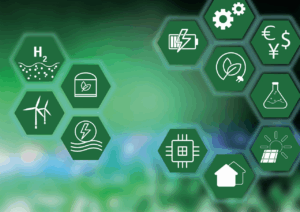By Diego Castrillon | July 13, 2022
Energy Transition: Why the Lightest Element Could Power a Net-Zero Future
Yes, we are talking about “hydrogen.”
You probably have seen this word gaining popularity recently. Countries are proposing hydrogen roadmaps and international agencies reporting on the number of hydrogen investments and production.
But what exactly is hydrogen for the energy system?
To begin with it is an energy carrier, or in other words, a source that allows the transporting of energy in a usable form from one place to another. Like other energy carriers, such as electricity, hydrogen must be produced from another substance/source, such as water, fossil fuels, or biomass, to be used as energy or fuel.
Bear with me as this is the moment when things start getting complex!
Depending on the source of hydrogen production, hydrogen has different denominations including:
- Grey hydrogen, generated from natural gas or methane through a process called “steam reforming.” A similar approach is presented in black and brown hydrogen produced from bituminous or lignite coal. However, these last two have high quantities of CO2 and carbon monoxide.
- Blue hydrogen, generated with the carbon from steam reforming but captured and stored underground through carbon capture and storage alternatives (CCSA).
- Green hydrogen, generated from clean energy from renewable energy sources (solar and/or wind) to split water with a process called electrolysis into hydrogen and oxygen.
- Pink hydrogen, also generated through electrolysis powered by nuclear energy, or
- Turquoise hydrogen, made from methane pyrolysis to produce hydrogen and solid carbon.
As you can see, there is an array, or even a “rainbow” of possibilities to produce hydrogen.
However, if our focus and target is to reach net-zero objectives unconditionally, this required outcome implies aiming for the less carbon-intensive production source, being green or blue hydrogen (as long as CCSA are safely stored with no potential leakages).
Some studies show how blue hydrogen may prevent us from reaching net-zero, as it may present a “lock-in” in of fossil fuels. Since blue hydrogen requires methane from natural gas, the potential “fugitive” methane emissions generate a carbon footprint that is 20% greater than burning either natural gas or coal directly for heat. (1)
Therefore, we should expect to hear and continue hearing about the deployment of money into green hydrogen production, storage, and distribution. In a world with an incoming surplus of pure renewable power supply, green hydrogen seems the obvious choice as a new energy source, for instance, in fuel or ammonia. At the same time, green hydrogen can help solve one of renewable energy’s most significant challenges: intermittency. Hydrogen can be produced by the overproduction of electricity and then stored to be used in high-demand moments.
Meeting the target for a net-zero world in the context of current geopolitical issues calls for quicker deployment of the hydrogen industry.
In a series of blogs, we will explore different areas of the hydrogen industry, both as an energy source and storage method. Both aspects are being built into project pipelines with massive amounts of money being spent, so it is essential to be aware of this reality-changing weapon underlying (and not underlying) conditions.
- Friedlander, B. (2021). Touted as clean, “blue” hydrogen may be worse than gas or coal. Cornell Chronicle. https://news.cornell.edu/stories/2021/08/touted-clean-blue-hydrogen-may-be-worse-gas-or-coal
Please use links below to find out about Pivotal180 and our financial modeling courses and experience the Pivotal180 difference.
Share This Resource

